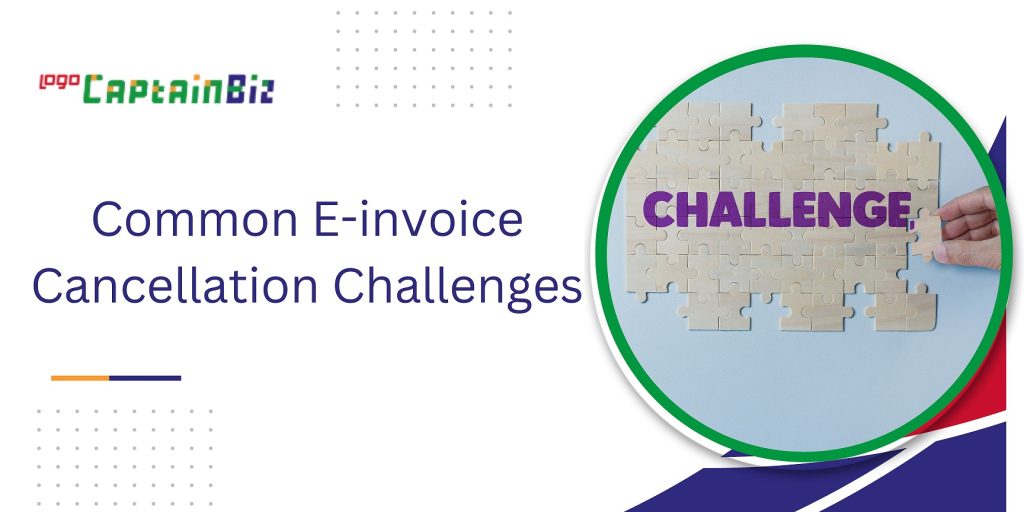The practice of electronic invoicing has become a game-changer in the dynamic world of modern business, where digital transformation is fostering unparalleled efficiency and innovation. Electronic invoicing improves transparency, minimises paperwork, and expedites financial operations.
The procedure for cancelling an electronic invoice is one of the most important of these issues, but like any technological breakthrough, it has its share of drawbacks. Let’s explore the E-invoice cancellation challenges, the difficulties organisations encounter, and the creative solutions that are changing the face of financial management in the digital era.
What is E-invoice Cancellation?
Cancelling an electronically generated invoice is known as an E-invoice cancellation. When mistakes, inconsistencies, or other problems are found in the initial invoice, it becomes imperative.
The buyer can easily cancel a purchase using the straightforward E-invoice cancellation process, which also works well if the E-invoice is entered incorrectly or twice. The time frame for amending and revoking an electronic invoice is 24 hours.
Why is E-invoice Cancellation done?
An invoice should only be cancelled if a mistake has been made. A mistake could be the wrong client, contact, or address on the invoice. A valid justification to withdraw the bill would be if it were a duplicate for services that have already been invoiced.
How to do E-invoice Cancellation?
The government portal offers two E-invoice cancellation processes.
Cancel a Single Bill
- After logging in, select Cancel from the sidebar of the E-invoice site.
- Click Proceed after entering the IRN or the Acknowledgment number.
- Pick the E-invoice, explain the cancellation, and press Submit.
Cancel E-invoices in Bulk
- Go to the gateway for E-invoicing. Go to Tools -> Bulk Generation Tools under Help.
- Get the offline E-invoice Cancel by IRN – JSON Preparation tool.
- After entering the IRN, the cancellation reason, and the cancellation remarks, click Validate.
- After the file has been confirmed, click Prepare JSON.
After logging in:
- Go to the E-invoice site.
- Select Bulk IRN Cancel, then E-invoice.
- Submit the JSON file.
What happens when you cancel an E-invoice?
There are significant ramifications for businesses and taxpayers from India’s decision to discontinue the E-invoice system. The main effect is that producing GST invoices now involves more paperwork and manual procedures. Businesses were merely required to keep a sales register or journal to record all sales invoices before implementing the E-invoice system.
Companies must now create hard copies of every invoice and keep track of both the sales register and the hard copies of the invoices. Businesses of all sizes will surely face higher expenses and administrative challenges due to this.
How does E-invoice Cancellation Affect Businesses?
The E-invoice cancellation will significantly impact the Indian business community. This is a result of the E-invoice system’s introduction, which streamlined and improved the efficiency of the electronic invoicing system. Businesses had to create an electronic invoice under this method, which they had to send to the GST portal.
Next, the E-invoice portal would be validated by the portal. And produce an EIN or unique identification number. Businesses would use this EIN to monitor the status of their bills.
What are the Common E-invoice Cancellation Challenges and How to Overcome Them?

Business owners must stay current with electronic invoicing—some of the E-invoice cancellation challenges and E-invoice cancellation solutions are as follows:
ERP System and Integration Changes
For invoice data to flow smoothly, enterprise resource planning (ERP) systems must be integrated with the GST Suvidha Provider (GSP), Application Suvidha Provider (ASP), and Invoice Registration Portal (IRP).
It can be challenging to modify ERPs so that they comply with the standard E-invoice structure, nevertheless. Businesses handling high invoice numbers may encounter difficulties if there is a lack of integration, underscoring the necessity of smooth integration to guarantee compliance.
Solution
Evaluate and record the essential ERP system modifications needed to integrate E-invoices. Create a well-thought-out change management plan to reduce hiccups. Work collaboratively with the business and IT departments to minimise E-invoice cancellations and guarantee a seamless transition.
Sorting Invoices
Only bills between businesses can be sent via the E-invoicing system. B2B invoices must be filtered out of a list to be created as an eway invoice. It will take a lot of time and work to complete this bifurcation process.
Solution
Install a reliable E-invoicing software such as CaptianBiz that uses preset parameters to distinguish between B2B and B2C transactions automatically. To guarantee precise classification, establish explicit business rules and invoice segregation procedures. Maintain system audits and monitoring to correct misclassifications and stop E-invoice cancellations.
E-invoice Cancellation and Amendment
Even little adjustments require a complete invoice cancellation; partial cancellations are impossible with E-invoices. On the IRP, cancellations are accepted for 24 hours; beyond that, they must be made through the GST site.
It’s also not allowed to raise a fresh electronic invoice with the same number. The amending process becomes more complicated when taxpayers need to change the invoice number and create a new electronic invoice.
Solution
Create an automated, optimised E-invoice amendment procedure in your ERP system. Make sure there are effective channels of communication for notifications of amendments with trading partners and tax authorities.
Establish a thorough audit trail and reconciliation system to monitor all E-invoice modifications and cancellations for accuracy and compliance.
Data Storage Options
An alternative data storage mechanism is required because the Invoice Registration Portal only keeps data for 24 hours.
Solution
Establish a safe and legal data storage system that makes it simple to access records of E-invoice cancellations. Establish data archiving procedures to provide cost-effective long-term storage and accessibility. To protect against potential data loss or system failures, regularly test and back up your data recovery procedures.
Systemic Problems
The implementation of E-invoicing in India has caused the GST to move towards stability. Even though the October 2020 E-invoicing provision has been somewhat relaxed, you may still need help with system stability. Users also report issues with Masters, like erroneous HSN/SAC or GSTIN codes.
Solution
Conduct a thorough system stability assessment to identify and address performance bottlenecks and vulnerabilities. Implement regular system maintenance and updates to ensure optimal stability for E-invoice processing. Establish redundancy and failover mechanisms to minimise disruptions and downtime in case of system failures.
Best Practices for E-invoice Cancellation: Ensuring Accuracy and Compliance
What are the Benefits of Efficient E-invoice Cancellation?
Effective E-invoice cancellation has several advantages for financial transactions and digital invoicing.
Reduced Errors
It simplifies fixing mistakes or resolving inconsistencies in electronic invoicing first and foremost. This enhances overall financial management by reducing the likelihood of financial conflicts and improving the accuracy of financial records.
Time-Saving
Efficient E-invoice cancellation also lessens the administrative workload. It saves time and resources that would otherwise be used for manual paperwork and communication by enabling firms to swiftly revoke or alter invoices electronically.
Assures Tax Compliance
A clear, recorded trail of cancelled invoices promotes adherence to tax laws and auditing standards. This guarantees that firms follow the law and can be very helpful for tax reporting.
In general, the effectiveness of E-invoice cancellation promotes improved financial control, lowers operating expenses, assures compliance, and helps businesses adopt a more ecologically friendly strategy.
How to Streamline and Automate Your E-invoice Cancellation Process?
Your E-invoice cancellation procedure can be made more efficient and error-free by automating and streamlining the process. This is a quick illustration of how to accomplish it:
- Digital Workflow: Put in place a system to track the status of electronic invoicing. For instance, employ an enterprise resource planning (ERP) system of accounting software like CaptainBiz.
- Cancellation Requests: When necessary, users can use the system to submit requests to cancel invoices. These requests should contain pertinent details, including the invoice number, the cause for the cancellation, and any supporting paperwork.
- Automated Validation: Establish guidelines for automatically verifying cancellation requests. Verify that the requestor has the necessary authorization, for instance, or restrict the cancellation of invoices to those received during a specific period.
- Workflow Triggers: The system starts the cancellation procedure as soon as it is approved. This could entail notifying the appropriate parties, creating a credit note, or amending the invoice.
- Audit Trail: To ensure accountability and transparency, keep a thorough audit trail that documents every step made during the cancellation process.
- Analysis and Reporting: Create reports using the gathered data to help you see patterns, explain cancellations, and pinpoint areas where your processes need to be improved.
- You can minimise errors, increase productivity, and decrease manual intervention in your financial processes by automating E-invoice cancellations.
Amendments and Updates to E-invoice Cancellation Provisions
Conclusion
Businesses can improve compliance, streamline processes, and pave the path for an invoicing ecosystem that is more economical and efficient by recognising the challenges and putting creative solutions in place. Accepting these changes is not only necessary but also a chance to prosper in a financial environment that is changing quickly and remains competitive.
Get help with E-invoice cancellation solutions – CaptainBiz, a comprehensive business accounting, inventory management, and online billing software.
FAQs
-
What are the challenges faced by electronic invoicing?
Some of the challenges E-invoices face are ERP System and Integration Changes, Sorting Invoices and Systemic Problems.
-
What is the procedure to cancel E Invoice?
Contact your E-invoicing service provider or the appropriate tax authority to cancel an E-invoice. Then, follow their unique cancellation processes, which usually entail supplying the invoice details and the cause for cancellation.
-
What is the reason for the cancellation of the E-invoice?
Errors in the original invoice or the need to change transaction details, including wrong amounts or recipient information, are the usual causes of E-invoice cancellations. Maintaining precise financial records is a routine procedure.
-
What is an E-invoicing solution?
An E-invoicing solution is like a high-tech helper for businesses to make their money stuff faster and easier. It helps them make, send, get, and take care of invoices on the computer without paper. This digital system is handy because it keeps good records, follows the rules, and keeps your info safe when sending it.
-
Which software is best for E-invoice?
CaptainBiz, a comprehensive business accounting, inventory management, and online billing software, is one of the best E-invoice software.
-
Can I cancel an E-invoice?
Yes, you can cancel an electronic invoice within twenty-four hours of production.
-
Why should your company adopt an E-invoicing system?
Using E-invoicing can help your organisation remain effective and competitive in the current business environment since it is quickly becoming a standard practice in the business sector.
-
How can companies guarantee prompt deletion of electronic invoices?
It is possible to guarantee that cancellations are handled quickly by implementing clear cancellation procedures, training employees, and setting up notifications and reminders.
-
How can cancellation errors in electronic invoices be reduced?
Errors can be minimised by applying validation checks, employing standardised templates, and carefully examining invoices before submission.
-
What happens if an inaccurate E-invoice is not cancelled?
Faulty E-invoices should be cancelled immediately to avoid payment disputes, tax ramifications, and financial disparities between the vendor and the customer.

